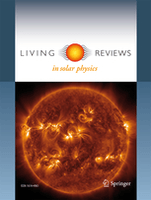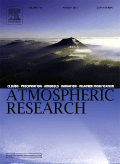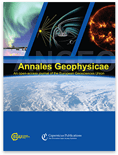
Weather
Scope & Guideline
Illuminating the Dynamics of Weather and Climate
Introduction
Aims and Scopes
- Space Weather Monitoring and Prediction:
Research in this area emphasizes the forecasting of solar events, such as coronal mass ejections (CMEs) and solar flares, and their impacts on the Earth's magnetosphere and ionosphere. - Ionospheric Dynamics and Modeling:
This scope includes studies on the behavior and characteristics of the ionosphere under various space weather conditions, utilizing advanced modeling techniques and observational data to predict ionospheric changes. - Geomagnetically Induced Currents (GICs):
Research focused on the effects of geomagnetic storms on electrical systems, including modeling and empirical studies to assess risks and mitigation strategies for power grids. - Thermospheric and Exospheric Studies:
Investigations into the thermosphere and exosphere's responses to solar activity, including the use of data assimilation techniques for improved density predictions. - Machine Learning Applications in Space Weather:
The journal also highlights innovative applications of machine learning methodologies for various predictive tasks related to space weather phenomena, enhancing forecasting capabilities. - Interdisciplinary Approaches to Space Weather:
Encouraging collaboration across disciplines, the journal addresses the societal impacts of space weather, including aviation safety, telecommunications, and power infrastructure.
Trending and Emerging
- Deep Learning and Advanced Machine Learning Techniques:
There is a significant increase in studies utilizing deep learning and advanced machine learning for forecasting and modeling space weather phenomena, indicating a trend towards more sophisticated analytical techniques. - Real-Time Space Weather Forecasting:
Research aimed at developing real-time forecasting systems for space weather is on the rise, driven by the need for timely information to mitigate risks to technology and infrastructure. - Interdisciplinary Applications of Space Weather Research:
An emerging theme is the application of space weather research to various sectors, including aviation safety, telecommunications, and power grid management, highlighting the societal relevance of these studies. - Integration of Multi-Source Data for Enhanced Predictions:
There is a growing trend towards integrating data from multiple sources, such as satellite observations and ground-based measurements, to improve the accuracy of predictions and models. - Investigating Space Weather Impacts on Health and Safety:
Research exploring the impacts of space weather on human health and safety, particularly for astronauts and aviation personnel, is gaining traction as the implications of space weather become more widely recognized.
Declining or Waning
- Historical Geomagnetic Event Analysis:
Research focusing on the historical impacts of geomagnetic storms has decreased, possibly due to a shift towards real-time monitoring and forecasting methods that prioritize current data over historical analysis. - Basic Empirical Models of Ionospheric Behavior:
There has been a decline in the publication of straightforward empirical models for ionospheric behavior, as more researchers are now favoring complex machine learning and data assimilation approaches that offer enhanced accuracy. - Non-Real-Time Data Assimilation Techniques:
The focus on non-real-time data assimilation techniques has diminished, with a growing emphasis on real-time applications and operational forecasting models in space weather research. - Single-Instrument Observational Studies:
The frequency of studies relying on single-instrument observations has waned, as the field increasingly values multi-instrumental and integrated observational approaches to provide comprehensive insights. - Static Models of Radiation Belt Dynamics:
Static models for predicting radiation belt dynamics are becoming less common, as researchers shift towards dynamic, data-driven models that can adapt to real-time changes in space weather conditions.
Similar Journals

Tethys-Journal of Mediterranean Meteorology & Climatology
Fostering Insight into Weather Variations Across the MediterraneanTethys - Journal of Mediterranean Meteorology & Climatology, published by the Associació Catalana de Meteorologia (ACAM), serves as a specialized platform dedicated to advancing the study of meteorological and climatological phenomena within the Mediterranean region. With a Scopus Rank of #94 out of 148 in the field of Atmospheric Science, this journal is positioned in the Q4 category, reflecting a growing recognition among researchers focused on regional climate variations and environmental challenges. Established in 2012 and publishing through 2023, Tethys aims to provide open access to high-quality research articles that address critical issues impacting climate and weather patterns, thus contributing to a deeper understanding of Mediterranean meteorology. The journal’s mission aligns closely with the increasing global emphasis on climate studies and serves as an essential resource for academics, practitioners, and students dedicated to sustainably addressing the environmental and climatic challenges faced by this diverse and dynamic region.

SPACE WEATHER-THE INTERNATIONAL JOURNAL OF RESEARCH AND APPLICATIONS
Connecting Disciplines through Space Weather ResearchSPACE WEATHER: THE INTERNATIONAL JOURNAL OF RESEARCH AND APPLICATIONS, published by the American Geophysical Union, is an influential journal dedicated to advancing the understanding of space weather phenomena and their applications. With an E-ISSN of 1542-7390 and a commendable Q2 ranking in the Atmospheric Science category for 2023, this journal serves as a vital platform for researchers, professionals, and students alike. The journal intersects multiple disciplines, including Earth and planetary sciences, focusing on how solar and cosmic phenomena affect the Earth's atmosphere and space environment. With its convergence years extending from 2005 to 2024, SPACE WEATHER aims to publish high-quality research that contributes to our understanding of these critical areas, fostering new ideas and technologies. Its strategic position in the Scopus ranking, being in the 69th percentile, highlights its integral role in the academic community, driving innovation and collaboration in this essential field.

Asia-Pacific Journal of Atmospheric Sciences
Exploring the Frontiers of Atmospheric ScienceWelcome to the Asia-Pacific Journal of Atmospheric Sciences, a leading publication in the field of atmospheric science, published by the Korean Meteorological Society. With an ISSN of 1976-7633 and an E-ISSN of 1976-7951, this journal has been a cornerstone for researchers and practitioners in the atmospheric sciences since its inception in 2008. Recognized for its rigorous peer-reviewed articles, it holds a commendable Q2 quartile ranking in 2023 and is placed at the 51st rank out of 148 in the Earth and Planetary Sciences, reflecting its impact within the community with a 65th percentile. The journal features a broad scope encompassing meteorology, climatology, and environmental sciences, making it an essential resource for scholars and industry experts alike. As an open access journal, it ensures that groundbreaking research is widely accessible, fostering collaboration and innovation across the Asia-Pacific region and beyond. Explore the latest findings and advancements in atmospheric sciences and contribute to the dynamic field of climate research through the journal's engaging content.

Living Reviews in Solar Physics
Unveiling Solar Secrets, One Review at a TimeLiving Reviews in Solar Physics is a premier open access journal published by Springer International Publishing AG, dedicated to the dynamic field of solar physics. Since its inception in 2004, this journal has provided a platform for comprehensive and up-to-date reviews that cover the latest developments in solar research, making it an invaluable resource for researchers, professionals, and students alike. With an impressive Q1 ranking in both Astronomy and Astrophysics and Space and Planetary Science as of 2023, it ranks in the top 3% of journals in its field according to Scopus. The journal's commitment to open access ensures that groundbreaking research is disseminated widely, fostering collaboration and innovation. As it continues to evolve through to its converged years from 2004 to 2024, Living Reviews in Solar Physics remains a crucial outlet for advancing our understanding of solar phenomena and their implications for astrophysics and planetary science.

JOURNAL OF GEOPHYSICAL RESEARCH-ATMOSPHERES
Connecting researchers with cutting-edge atmospheric insights.JOURNAL OF GEOPHYSICAL RESEARCH-ATMOSPHERES, published by the American Geophysical Union, is a leading peer-reviewed journal dedicated to advancing our understanding of atmospheric science and related disciplines. With an impressive impact factor and consistently holding a Q1 ranking across key categories including Atmospheric Science and Geophysics, this esteemed journal caters to a global audience of researchers, professionals, and students eager to explore groundbreaking studies and insights. The journal covers a comprehensive scope of topics, from climate dynamics to atmospheric processes, enhancing knowledge and informing practices within the realm of Earth and Planetary Sciences. With its strong emphasis on quality research, it remains a vital resource for those engaged in unraveling the complexities of our planet’s atmosphere. Explore this journal to stay abreast of significant developments and foster a deeper understanding in this ever-evolving field.

Weather and Climate
Illuminating Insights on Meteorological TrendsWeather and Climate is a prestigious, peer-reviewed journal published by the Meteorological Society of New Zealand, dedicated to advancing knowledge in the domains of meteorology and climatology. With the ISSN 0111-5499, the journal serves as a vital platform for researchers and professionals to disseminate impactful findings that address pressing issues related to weather patterns and climate change. Although it does not operate on an open-access model, it provides a wealth of valuable insights drawn from a diverse range of studies. The significance of this journal in the scientific community is underscored by its commitment to fostering interdisciplinary collaboration and sharing innovative research that can inform policy-making and environmental management strategies. Located in Wellington, New Zealand, Weather and Climate not only contributes to regional meteorological discourse but also holds relevance for the global scientific landscape, making it essential reading for anyone invested in the future of our changing climate.

Atmospheric Research
Pioneering Research in Climate and MeteorologyAtmospheric Research is a premier journal published by Elsevier Science Inc, specializing in the field of Atmospheric Science. With a commendable impact factor, it holds a distinguished position in the Scopus rankings, being placed 14th out of 148 journals within its category and achieving a remarkable 90th percentile rank. This journal serves as a vital outlet for rigorous research on atmospheric processes, climate variability, and meteorological phenomena, providing a platform for scientists, researchers, and students to disseminate their findings and contribute to the advancement of knowledge in this critical field. Although it is not an open-access journal, its strong reputation and selective publication criteria ensure that only high-quality and impactful studies are featured. Since its inception in 1986, Atmospheric Research has continuously evolved to meet the dynamic nature of atmospheric studies, making it a fundamental resource for anyone engaged in understanding and addressing atmospheric challenges worldwide.

Journal of the Korean Astronomical Society
Connecting Scholars: Bridging Ideas in Astronomy and AstrophysicsWelcome to the Journal of the Korean Astronomical Society, an esteemed publication dedicated to advancing the fields of Astronomy and Astrophysics as well as Space and Planetary Science. Established in 1993 and under the reputable auspices of the Korean Astronomical Society, this journal serves as a vital platform for researchers and scholars from South Korea and around the globe to disseminate innovative findings and critical insights. With a commendable Q2 ranking in Astronomy and Astrophysics and a Q3 ranking in Space and Planetary Science, this journal is positioned among the influential voices in its fields, fostering collaboration and knowledge exchange. The journal's rigorous peer-review process ensures that published works contribute significantly to ongoing discussions and developments in astronomical research. While currently not an open-access journal, it remains accessible to the academic community, encouraging readers to stay abreast of the latest advancements in the sciences that elucidate the universe's complexities. Join us in exploring the cosmos through cutting-edge research and scholarly discussion that propels the field forward.

ANNALES GEOPHYSICAE
Fostering Collaboration Across Geophysical DisciplinesANNALES GEOPHYSICAE is a distinguished open access journal published by COPERNICUS GESELLSCHAFT MBH, renowned for its contributions to the field of geophysics and related disciplines. Since its inception in 1996 as an open access journal, ANNALES GEOPHYSICAE has provided a vital platform for researchers to disseminate their findings covering a wide array of topics within Astronomy and Astrophysics, Atmospheric Science, and Earth and Planetary Sciences. The journal enjoys a commendable reputation, evidenced by its impressive 2023 category quartiles, ranking Q1 in Earth and Planetary Sciences (miscellaneous) and Q2 in several other relevant categories, reflecting its significance in the global research community. Based in Germany and accessible to a diverse audience, ANNALES GEOPHYSICAE serves as an essential resource for academics, practitioners, and students alike, striving to foster advancements in our understanding of geophysical phenomena and encouraging collaboration across disciplines.

TELLUS SERIES A-DYNAMIC METEOROLOGY AND OCEANOGRAPHY
Elevating Understanding of Dynamic Earth SystemsTELLUS SERIES A-DYNAMIC METEOROLOGY AND OCEANOGRAPHY, published by Stockholm University Press, is a prestigious open-access journal that has been at the forefront of research in the fields of atmospheric science and oceanography since its inception in 1983. With an enduring commitment to disseminating high-quality, peer-reviewed research, the journal has achieved a commendable impact factor, securing its position in the Q2 category for both Atmospheric Science and Oceanography as of 2023. The journal's significant reach is reflected in its Scopus rankings, being positioned at Rank #51 in Oceanography and Rank #77 in Atmospheric Science. With open access established since 2012, TELLUS SERIES A serves not only as a vital resource for researchers and professionals in these dynamic fields but also as an inclusive platform for budding scholars and students. Engaging with this journal allows readers to stay updated on the latest developments and groundbreaking discoveries that advance our understanding of climate systems and marine environments. Its editorial ethos emphasizes the cross-disciplinary integration of atmospheric and oceanographic studies, making it an essential publication for anyone invested in environmental research and policy.